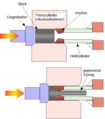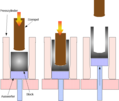Extrusion
The extrusion is a forming method for the manufacture of bars, wires , tubes , and irregular-shaped prismatic profiles . In plastics processing, the corresponding process is known as extrusion . According to DIN 8582, extrusion is counted as pressure forming, together with extrusion in the subgroup of pressing through , and is described in more detail in DIN 8583. During extrusion, a compact (block) heated to forming temperature is pressed through a die with a punch . The block is enclosed by a recipient - a very thick-walled tube. The external shape of the extruded strand is determined by the die. Cavities can be created by differently shaped mandrels. Extruded profiles can reach a length of up to 60 m; longer lengths are possible, but generally not economical. Extrusion is used to produce endless material that is cut to the desired length. In the related extrusion, however, individual pieces are produced.
In principle, all metals are suitable for extrusion, but it is mainly used for aluminum and aluminum alloys (e.g. heat sink profiles and construction profiles ), copper and copper alloys. (Seamless) tubes are made from stainless steel . Smaller quantities of magnesium and titanium alloys or solders are also extruded.
Advantages of extrusion are, in particular, the possibility of producing profiles in complicated shapes and from materials that are difficult to form, the high degree of deformation that can be achieved in one process step, and the low tool costs, which make extrusion particularly interesting for the production of relatively small batches.
Process variants
A distinction must be made between direct, indirect and hydrostatic extrusion as process variants.
In direct extrusion, the punch pushes the block along the inside surface of the recipient in the direction of the die. In order to generate this relative movement between the block and the recipient, high frictional forces must be overcome; However, the friction can also be used to hold back impurities from the block surface layer so that they do not get into the product. The directions of movement of the punch and the exiting strand are the same, hence the term forward extrusion.
In indirect extrusion , the recipient is closed on one side, and the die, which is located on the head of a hollow punch, is pressed onto the block from the other side. The strand passes through the punch hole. Their diameter thus limits the profile outline. This process is implemented in practice by pressing the recipient, closed on one side, together with the block over the fixed hollow punch with die. The term "backward extrusion", which is also used, can therefore be misleading. The advantage of the indirect pressing process, however, is that there is no friction between the transducer wall and the block, which means that lower pressing forces are required. Furthermore, qualitatively better products can be manufactured, since the absence of frictional forces leads to a more homogeneous structure.
With hydrostatic extrusion , the pressing force is not applied directly to the block by the punch, but rather via an active medium (water or oil). In this process, the so-called hydrostatic tension component - the compressive tension acting on the workpiece from all sides - is even higher and wire can even be pressed from a coil.
A recent special form uses frictional heat to make the starting material malleable, also known as the CONFORM process. A continuously fed wire with a diameter of usually 8 to 20 mm is heated by a friction wheel to over 500 ° C and the then doughy material is pressed through a die arranged immediately after the friction wheel. This continuous process is mainly used for small and medium-sized profiles made of aluminum and copper. The production process, which is possible continuously over a long period of time, and the fact that only a single, relatively small and simply built machine is required for this, enables a cost reduction of 30 to 50% compared to conventional extrusion processes.
literature
- Hinkfoth, Rolf: massive forming. Selected technological basics of the forming processes in metallurgy (rolling, drawing, extrusion, upsetting and stretching) treated with the help of the elementary plasticity theory in a global view for project planning, construction and technology. = Bulk forming process. Wissenschaftsverlag Mainz, Aachen 2003, ISBN 3-86130-184-9 .
- Martin Bauser, Günther Sauer, Klaus Siegert: Extrusion. 2nd Edition. Aluminum-Verlag, Düsseldorf 2001, ISBN 3-87017-249-5 .
Web links
- TU Berlin Research Center for Extrusion: General information on extrusion including animations
- Animation: extrusion process
- Wrought aluminum alloys for extrusion (chemical composition according to DIN EN 573-3) (PDF file; 83 kB)
- Comparison of previous DIN standards and new EN standards for wrought materials made of aluminum (PDF file; 144 kB)





